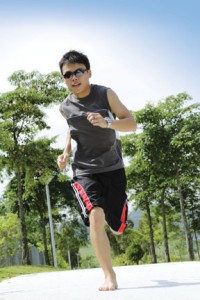| << Back |
Feeling Fit: Shoeless in Sin City – Is Barefoot Running for You?
By Aly Wagonseller
Since ancient times, man (or caveman for that matter) has traversed his turf either barefoot or in unsupportive moccasins; scurrying after food, running from danger and living everyday life sans rubber soles. Pedi-perfect deficient by modern standards, feet were visibly wider, more rugged and markedly stronger back then, providing a base for the human body that many experts believe resulted in superior balance and agility, while warding off back, hip, knee and foot injuries.
Despite the invention of cushiony Nike Airs, modern day cultures like the Tarahumara Indians of Mexico”s Copper Canyon confirm that running in minimalistic shoes or barefoot prevents injury. The Tarahumara are famous for running in homemade sandals over rough terrain for hundreds of miles at a time, with little to no incidence of hip, knee or back injuries, and many of them sprinting well into their 80s. In addition, athletes from Kenya have been winning marathons in the barefoot buff for years. It’s got a growing number of running experts thinking outside of the proverbial shoe box.
Going Au Naturale
The argument against shoes starts with their inherent interruption of the natural gait. The theory is that padded and restrictive tennis shoes encourage the runner to place the initial shock of landing disproportionately on the heel of the foot, while running barefoot allows for the weight to be distributed on the ball or mid-range of the foot. In terms of injury, it’s thought that less stress is put on the joints when the “strike point” is shifted to the front or mid part of the foot, as in the case of running barefoot.
This point is illustrated in a study conducted by Harvard University on 68 young, healthy runners of mixed gender. Participants were evaluated by a motion analysis machine while running in both shoes and barefoot. The researchers observed a 54% average increase in the internal rotation torque of the hip, and a 36% increase in the bending force of the knee when using running shoes compared to barefoot running. The study concluded that although padded running shoes protect the feet from the environment, they do have straining effects on critical joints associated with injury.
In addition to strain on the joints, it’s also thought that shoes impair the natural foot to brain connection needed for proper balance and strength. The foot contains more than 200,000 nerve endings, 33 major muscles and 19 ligaments. When placed in an overly padded, restrictive shoe, these nerves and muscles lose their ability to “feel” the ground beneath them. This lack of feeling not only hinders the brains ability to process pain from the constant impact of improperly striking the ground heel first, but also fosters inactivity and promotes weakening of muscles and tendons needed for proper balance.
On the Other Foot
While there are many who support the idea of running without shoes, they do provide the necessary protection against local hazards that include hot, desert asphalt and debris like rocks, nails and thorns. And, while a number of shoe brands like Vivo Barefoot, Nike Free and the Vibram Five Finger shoes attempt to mimic barefoot running while providing a certain degree of protection from road hazards, starting a barefoot running regime can easily cause injury to ankles, feet, calves and Achilles tendon. To avoid injury, remember:
- Start slow and consider running on indoor tracks or hard surfaces free from dangerous elements.
- Listen to your body. If you feel pain and/or strain, stop or reduce your running time until you get used to your new gait.
- Glean information from sources that include www.barefootrunner.com, http://runnatural.org and various books on the subject. A simple Google search on “barefoot running” turns up a wealth of information.
The scientific jury’s still out on whether running barefoot is better. More studies are being conducted every year, with L. Daniel Howell, the author of The Barefoot Book: 50 Great Reasons to Kick off Your Shoes, and organizations like the Society for Barefoot Living (www.barefooters.org) leading the way. It would seem our ancestors have already spoken on the subject, yet in a high tech world of Nike Airs, only time will tell.








